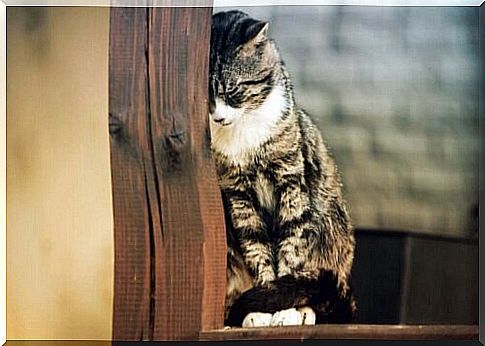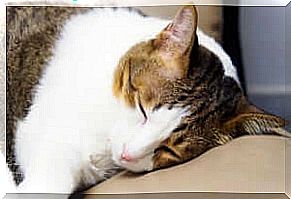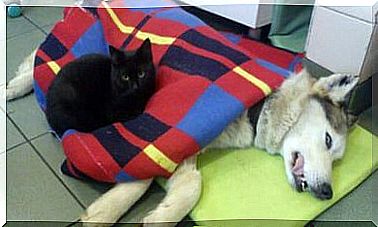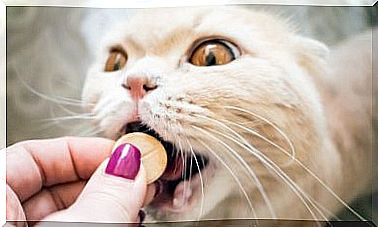The Three Most Common Mental Illnesses In Cats

Behavioral disorders can be associated with the presence of mental illness. This fact is evident to us in humans, but animals can also develop pathologies that affect their physical and mental conditions. In cats, the most common mental illnesses are stress, depression and epilepsy.
All these alterations have different origins and treatments. If as a feline guardian you suspect your pet may exhibit similar symptoms, you should see your veterinarian or consult a feline behavior specialist. In the following lines we present the three most common mental illnesses among domestic cats.
Three mental illnesses in cats
1. Stress in cats
The presence of stress in cats can seriously compromise their health, because it continuously affects the immune system and can lead to eating disorders, alopecia and abnormal behavior.
A stressed cat can become aggressive and exhibit compulsive and repetitive behaviors, such as stereotypies. Other obvious symptoms of stress are the following:
- Failure to use the sandbox.
- Mark the furniture in the house, both with urine and with nails.
- Show hyperactivity.
- Excessive meowing.
- Increase or decrease in grooming activities. Excessive licking can cause hair-free areas to form on the skin: this phenomenon is known as “psychogenic alopecia”. Considerable ingestion of hair also damages the digestive system.
Some common causes of stress can be changes in his environment or routine, the arrival of other animals in the house or the lack of sufficient stimuli, caused by poor environmental enrichment.

To treat a stressed cat, you can consider facilitating its adaptation to new changes with the help of pheromones.
Furthermore, it is possible to avoid this feeling by adequately introducing any new members of the family or by improving the enrichment of its environment by equipping it with new places dedicated to rest, or with toys, scratching posts, windows (always insured) from which to observe the outside, etc.
Stress may not belong to the category of mental illness in cats, but it is undoubtedly a major detonator of both physical and mental alterations.
2. Mental illnesses of cats: depression
Depression is a common disease among cats, which often goes unnoticed. Cats are very sensitive animals and any changes can affect their lives more than we can believe.
Symptoms of depression in felines can be mistaken for the habits of a quiet cat. It is important, however, to give them the right importance, because depression can damage the animal’s health. Some signs of this pathology are the following:
- The cat sleeps more hours than normal.
- Apathy. The animal loses interest in its surroundings, it does not interact with its objects or with other animals or people.
- He stops taking care of his own hygiene.
- Does not use the sandbox.
- He is shy or irritable when we try to relate to him.
Lack of freedom (especially if it is a cat used to leaving the house), a move, spending a lot of time alone, the loss of a family member (be it a person or another pet), the development of illness, lack of stimulation or poor nutrition are some of the reasons that can trigger depression in cats.
If you think this may be the case, contact your veterinarian and never give medication on your own initiative. In many cases, stress and depression can be treated by paying particular attention to the environment in which the animal lives.

3. Epilepsy in cats
Epilepsy is a neurological disorder that causes transient episodes of convulsion. Convulsive attacks are not always synonymous with epilepsy, because they can also appear following the presence of endocrine, metabolic or cardiovascular diseases, or due to acute pain.
We speak of epilepsy only when the convulsions have an intracranial origin. Once the vet has confirmed the presence of epilepsy in the feline, try to identify the triggers of the seizures or if, on the contrary, it is an idiopathic epilepsy or, in other words, without a known cause.
In cats, only between 15 and 25% are cases of idiopathic epilepsy. For this reason, it is of great importance to identify any type of pathology that can cause epilepsy due to an organic cause:
- Feline leukemia virus (FeLV)
- Feline Immunodeficiency Virus (FIV)
- Toxoplasmosis
- Tumors
- Malformations
Idiopathic epilepsy generally appears in cats between the ages of one and three. Furthermore, animals usually do not exhibit any anomalies between one seizure and another. As a result, symptoms other than convulsions are unlikely to occur during the vet visit.
Also, being such sudden and exaggerated movements, the guardians of epileptic cats often get alarmed and are not very objective in describing what happens to their pet. The attacks are usually short-lived, not exceeding one minute, and when they finish the animal appears to be in perfect condition, to the point of quickly heading for its own food bowl.
If you have ever witnessed a seizure or your cat has been seized, even on one occasion, you should go to your vet, who will have your pet undergo a neurological examination.
Epilepsy can be treated with the use of drugs. It cannot be cured completely, but the treatment is able to reduce the frequency with which the seizures appear and guarantees the animal an improvement in the quality of life.

As you have seen, cats can also suffer from mental illnesses, which in most cases are triggered by the presence of stress. In these cases the symptoms are very similar and you need to pay attention to them before the problem gets worse.









